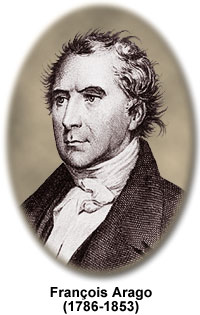Dominique-François-Jean Arago
(1786-1853)

Dominique-François-Jean Arago, better known simply as François Arago, was born on February 26, 1786 in Eastagel, France. A member of a political family, Arago was provided with a classical education, studying first at Perpignan and then at the École Polytechnique in Paris. In 1809, at the age of 23, Arago became a professor of analytical geometry at the prestigious Paris school and was subsequently made director of the Paris Observatory. Interested in a variety of scientific fields, Arago's greatest contributions were in optics, astronomy, and electromagnetism. A staunch republican, Arago was also active in politics and was a distinguished statesman later in life.
During the 19th century, there was a great controversy regarding the nature of light. Scientists generally subscribed to one of two opinions; either light existed as particles, or as a wave. Arago is best known for helping resolve this debate. Originally a supporter of the corpuscular, or particle, theory, polarization research he conducted out in collaboration with Augustin-Jean Fresnel changed his mind. In 1811, the pair discovered that two beams of light polarized in perpendicular directions do not interfere, eventually resulting in the development of a transverse theory of light waves.
Arago realized that if light was really a wave, its velocity should decrease when it passes into a denser substance. Therefore, he determined that the only way to truly prove that light traveled in waves was to measure its velocity in two different mediums. In 1838, he described an elaborate series of experiments, planning to use water and air as the opposing vehicles for light beams, but his work was delayed by circumstances beyond his control. Problems with laboratory equipment, political turmoil, and failing eyesight hindered progress, but the tests were finally performed in 1850, albeit not by Arago. Armand Fizeau and Jean-Bernard-Leon Foucault carried out the research, completing Arago's work three years before his death and confirming his hypothesis.
Arago was renowned not only for his own scientific findings, but for his influence on the work of others. In the 1820s, Arago performed numerous experiments concerning the relationship between magnets and electric currents. Another French scientist, Andre Ampere, was intrigued by his research and the pair decided to combine their efforts. Their work would eventually inspire Michael Faraday's explanation of electromagnetic induction. Arago was also instrumental in the success and funding of Louis-Jacques-Mandé Daguerre's photographic process, known as the daguerreotype, and directed studies that directly led to the discovery of the location of Neptune by Urbain-Jean-Joseph Le Verrier.
